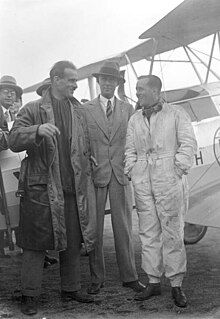de Havilland DH.60 Moth
| de Havilland DH.60 Moth | |
|---|---|

|
|
| Type: | Trainer aircraft |
| Design country: | |
| Manufacturer: | |
| First flight: |
February 22, 1925 |
| Number of pieces: |
> 2000 |
The de Havilland DH.60 Moth ("Motte") was a two-seat biplane made by the British manufacturer de Havilland Aircraft Company . Several other models were derived from the aircraft built from 1925 and named after different types of moth. The Moth was one of the most successful British aircraft of the interwar period.
The designer Geoffrey de Havilland was an avid butterfly collector and often gave his aircraft the names of insects.
history
The DH.60 Moth was the successor of the underpowered DH.53 Humming Bird . The maiden flight took place on February 22, 1925.
The Moth was a biplane with a plywood fuselage that was placed on the lower wing. The wings consisted of a wooden structure with fabric covering. Geoffrey de Havilland chose the four-cylinder in-line ADC Cirrus engine , which was based on a Renault eight -cylinder engine from the First World War . Later, more powerful drives developed in-house, the Gipsy motors, were available.
Because of its low purchase price and its “good nature”, the Moth was very popular with private pilots. At times, the Gipsy Moth dominated 85 percent of the private aircraft market in Great Britain, with an average of more than three aircraft being delivered per day.
In the 1930s, the Moth was developed into a training aircraft . Most of the pilots in the Battle of Britain had been trained on the Tiger Moth .
Versions
The DH.60 Moth was powered by an ADC Cirrus engine. Some examples received a modified chassis with X-shaped struts and were therefore designated as DH.60X.
The machines equipped with a Gipsy drive since 1927 were given the name DH.60G Gipsy Moth, while the original version was called the Cirrus Moth to distinguish it. The DH.60 GIII Moth Major version with a Gipsy Major engine was later developed .
Some machines received an Armstrong Siddeley Genet drive and were therefore called Genet Moth.
- DH.60 Moth / Cirrus Moth
- Original version with a Cirrus engine, 113 copies, including 24 licensed buildings
- DH.60G Gipsy Moth
- Version with a Gipsy engine, 692 copies, including 98 license builds
- DH.60GIII Moth / Moth Major
- 113 copies with Gipsy III or Gipsy Major engines
- DH.60M Moth
- 753 copies, including 171 licensed buildings
- DH.60T Moth Trainer
- 64 copies
- DH.60X Moth
- Version with modified chassis, 338 copies
More moth planes
The best known moth was the DH.82 Tiger Moth from 1931, a further development of the Moth Major.
- de Havilland DH.61 Giant Moth
- de Havilland DH.71 Tiger Moth ( monoplane )
- de Havilland DH.75 Hawk Moth
- de Havilland DH.80 Puss Moth
- de Havilland DH.81 Swallow Moth
- de Havilland DH.82 Tiger Moth
- de Havilland DH.83 Fox Moth
- de Havilland DH.85 Leopard Moth
- de Havilland DH.87 Hornet Moth
- de Havilland DH.94 Moth Minor
Military users
|
|
Technical data (DH.60G Gipsy Moth)
| Parameter | Data |
|---|---|
| crew | 1 |
| Passengers | 1 |
| length | 7.30 m |
| span | 9.15 m |
| height | 2.70 m |
| Wing area | 22.6 m² |
| Empty mass | 420 kg |
| Takeoff mass | 800 kg |
| Cruising speed | 137 km / h |
| Top speed | 169 km / h |
| Engines | a vertical 4-cylinder in- line engine de Havilland Gipsy I with 75 kW |
See also
Web links
- Image and information (English)
- Information Florida International University (English)
- more pictures on airliners.net (English)
Individual evidence
- ↑ Barry Ketley, Mark Rolfe: Luftwaffe Fledglings 1935-1945. Luftwaffe Training Units and their Aircraft. Hikoki Publications, Aldershot 1996, ISBN 0-9519899-2-8 , p. 11.


